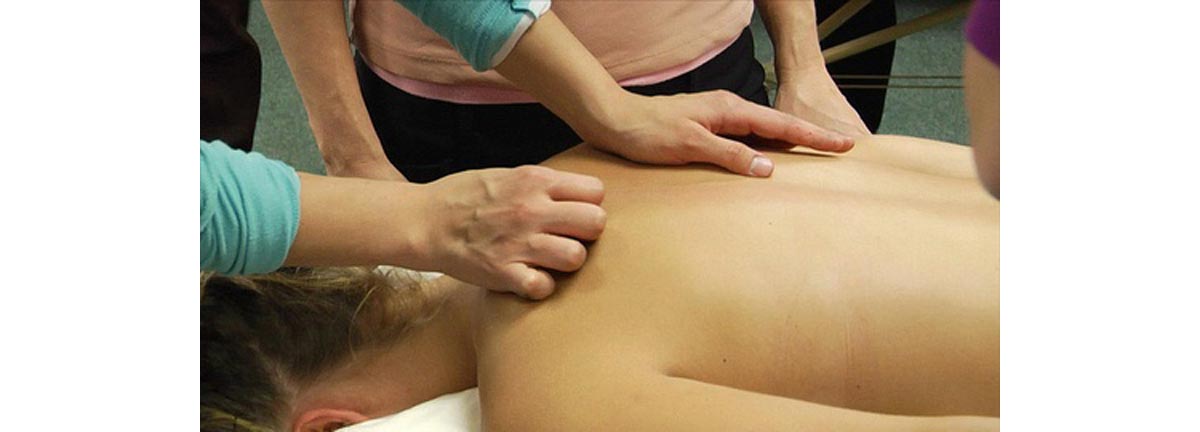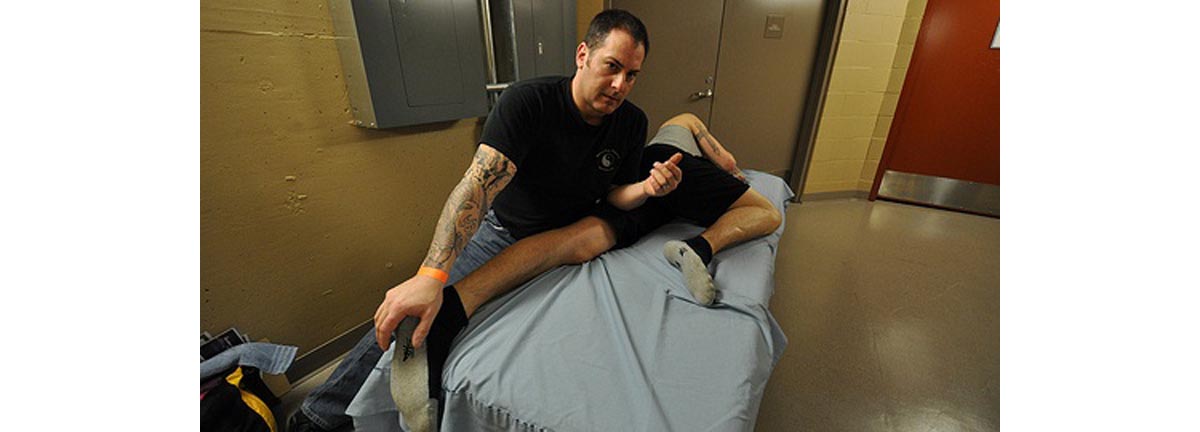If you’re feeling beat up from your last workout, or looking for something that will improve your recovery, a sports massage is the answer.
If you have ever had a Swedish massage or experienced pampering treatments at a spa, you will undoubtedly know that these types of messages can offer a very relaxing and pleasurable experience. A sports massage, though, is a whole different ball game.

A sports massage goes a lot deeper than your traditional relaxation massage, and can certainly be fairly uncomfortable or even outright painful, as the therapist works to get all the aches, pains, twinges and adhesions out of your muscles. But in the end, that pain is worth it, as sports massages have a host of benefits.
The main benefit of a sports massage is that it reduces muscle tension, much like a Swedish massage does though. While your Swedish massage might be suitable for the average non exercising office worker, if you’re training hard and pushing your body to its limits at the gym on a near daily basis, this simply won’t be enough for you. After a tough training session, you’ll nearly always be sore, and this soreness is caused in large part by a tightness in the muscles. While tight muscles aren’t an issue in themselves, they can lead to complications down the line if they’re not addressed.
Read more: Top Five Post Workout Meals
Think of your muscles like an elastic band – the tighter they are, the more prone they are to snapping. Excessively tight muscles, when left untreated over a longer period of time, are far more likely to suffer tweaks and twinges, even if you don’t experience a full rupture or tear.
You might think that you can stretch to reduce muscle tightness, but this often simply isn’t enough. The effects of stretching are fairly short term, meaning that within a few hours, your muscles could have seized up again. Stretching doesn’t get deep enough either. A skilled sports massage therapist can get deep into the muscle tissue, and not only relieve tightness, but also break up trigger points and adhesions. These are knots in the tissue that cause tightness, and that no amount of stretching will remedy.
A further benefit of sports massage is its effect on the circulatory and lymphatic systems.
Your circulatory system pushes blood around the body, and having a sports massage stimulates your body's natural action to get the blood flowing faster. Blood contains essential components for post workout recovery – oxygen, nutrients, and red and white blood cells. By getting more of these essential nutrients to the muscle tissue more quickly, damaged fibers can be repaired quicker, and your soreness will go away much sooner.
The lymphatic system pushes a fluid called lymph around the body. When this system becomes congested or slows down, it can lead to swelling around the joints known as edema (or, in plain English, excessive fluid buildup). Just like with the circulatory system, massage speeds up the functioning of the lymph system, and reduces swelling and inflammation.
Linked in with reducing tension, massage can improve your flexibility and mobility too. This is absolutely vital for avoiding injuries and improving your athletic performance. Many athletes find that they need a certain degree of flexibility to perform particular movements in their sport, and even regular gym goers can find that restricted mobility can stop them from performing various exercises. Sports massage is better than stretching for this set of very convincing reasons:
- Go back to the muscle/ elastic band analogy. If you stretch an elastic band over and over again, it does become more stretchy, but it also gets significantly weaker, making it more likely to snap. Massage though, increases flexibility without decreasing strength, by breaking down knots, rather than stressing and pulling the fibers.
- Massage is clearly extremely beneficial, whether you’re an elite athlete, a hardcore gym trainee, or just looking to maintain your general health and fitness. But when should you get a sports massage, and what should you be looking for when you decide to go ahead?
Best Timing For A Sports Massage
Straight After a Workout
The obvious time to get a sports massage is as soon as you’ve finished your workout. This is a great time for a number of reasons.

Firstly, you’re already in the gym, which, if your massage therapist is also based in the gym (which they often are) makes it the ideal opportunity as you don’t have to make two separate journeys.
Your muscles will already be warm from the workout too, so you won’t have to do any warm up exercises or stretches. Massaging cold muscles can be very uncomfortable, and not as effective as when the muscles are warm. The massage therapist has to spend more time easing into the full massage, and often can’t get as deep into the tissue, if you have not recently exercised. They may even ask you to wear warm clothing or compression gear to your treatment so that the muscles start warming up beforehand, or get you to do some light cardio, mobility work or stretching, which can add 10 or 15 minutes on to your treatment. After a workout though, you don’t need to do anything else, as your muscles are primed to go.
Read more: How to Avoid Sore Muscles after a Workout – and What to Do When Muscle Pain Occurs?
Secondly, massage is far more beneficial than stretching at reducing that awful DOMS – Delayed Onset Muscle Soreness. Seeing as many people skip stretching and cool down exercises post workout anyway, due to time constraints, or just simply being too tired from the session, a sports massage is a great way to relax and unwind when you don't want to do anything else after a hard training session.
Having a sports massage after a workout also means your recovery process starts sooner. You’ll get more blood round the body, pushing nutrients into the muscle cells, making them rebuild and repair straight away, so you’ll be ready for your next workout in no time at all.
Before a Workout
Not many people have pre workout massages, but they can be an extremely useful performance boosting tool.
The increased blood flow aids your muscles in warming up, and increases mobility without stretching and weakening the fibers. A pre workout massage will be different to a regular sports massage in a few ways though.
This type of sports massage will likely be a lot shorter, as you don’t want to start to relax – you need to be pumped up and motivated before you train, not spaced out and tired. It will also be more aggressive – the therapist will apply a lot of pressure and work at speed, to activate more muscle fibers. You’ll often see pre workout massages taking places at big events such as marathons and weightlifting competitions.
The increased blood flow aids your muscles in warming up, and increases mobility without stretching and weakening the fibers. A pre workout massage will be different to a regular sports massage in a few ways though.
This type of sports massage will likely be a lot shorter, as you don’t want to start to relax – you need to be pumped up and motivated before you train, not spaced out and tired. It will also be more aggressive – the therapist will apply a lot of pressure and work at speed, to activate more muscle fibers. You’ll often see pre workout massages taking places at big events such as marathons and weightlifting competitions.
In Between Workouts
If you’re sore, there’s no better way to feel better than a sports massage. Be warned, you may be feeling very tender, and it will be even more uncomfortable than usual, but you’ll come out of the treatment room feeling refreshed, re-energized, and a lot less sore than when you went in.What to Look For
Your therapist should have a recognized qualification from a University or an accredited massage education provider. They should also be a sports massage therapist or physiotherapist, rather than a general massage therapist who is only trained to perform relaxation massages. Make sure that your sports massage therapist asks you questions about your general health condition, injuries, and medical history prior to starting, and give them any feedback you have. An effective sports massage should be uncomfortable, but shouldn’t be excruciatingly painful, so let them know if it gets too much.- “Sports Massage” By Brian Mackenzie Accessed on July 8th, 2012 Retrieved from http://www.brianmac.co.uk/massage.htm
- Photo courtesy of wistechcolleges on Flickr: www.flickr.com/photos/wistechcolleges/7221625780
- Photo courtesy of superwebdeveloper on Flickr: www.flickr.com/photos/superwebdeveloper/4301580551

